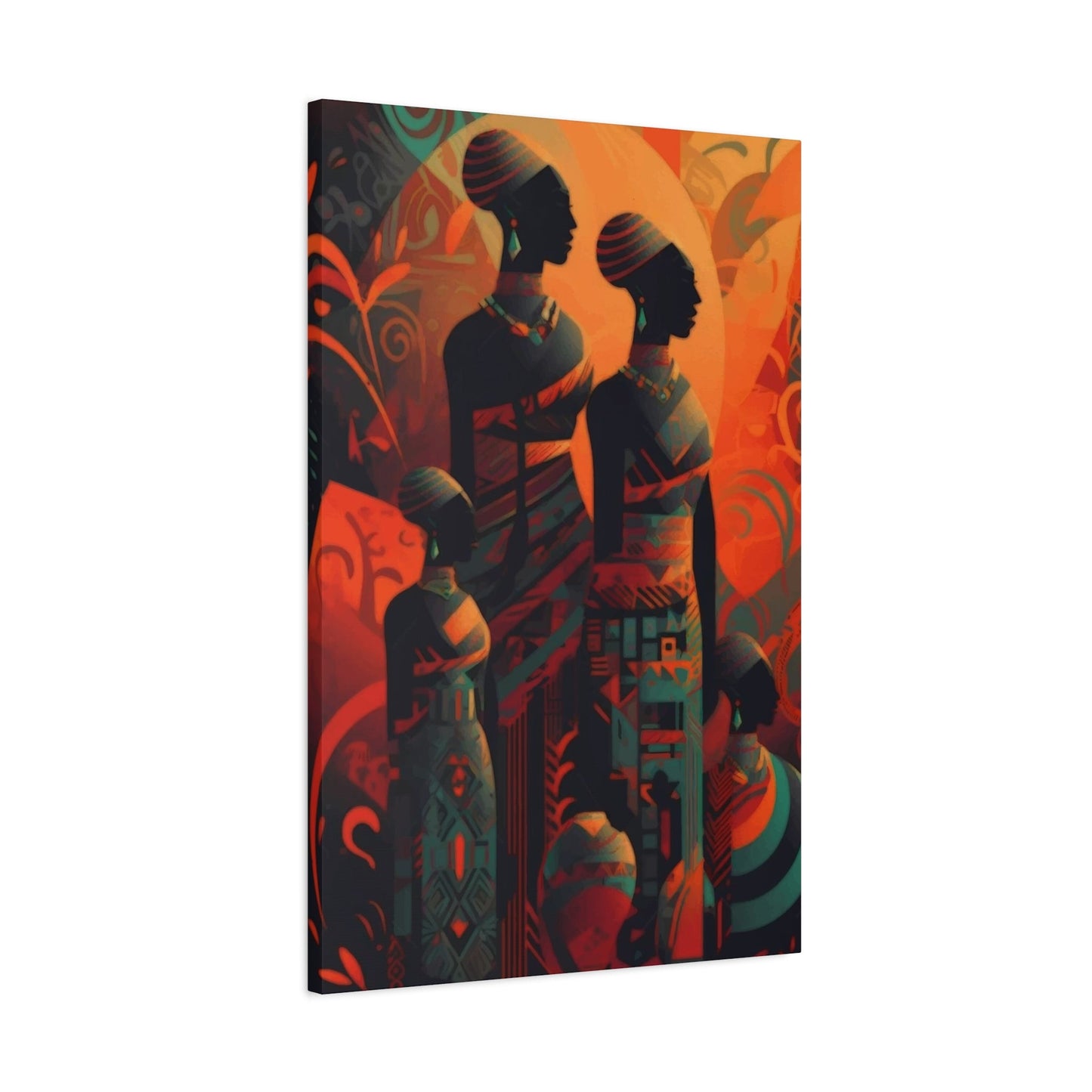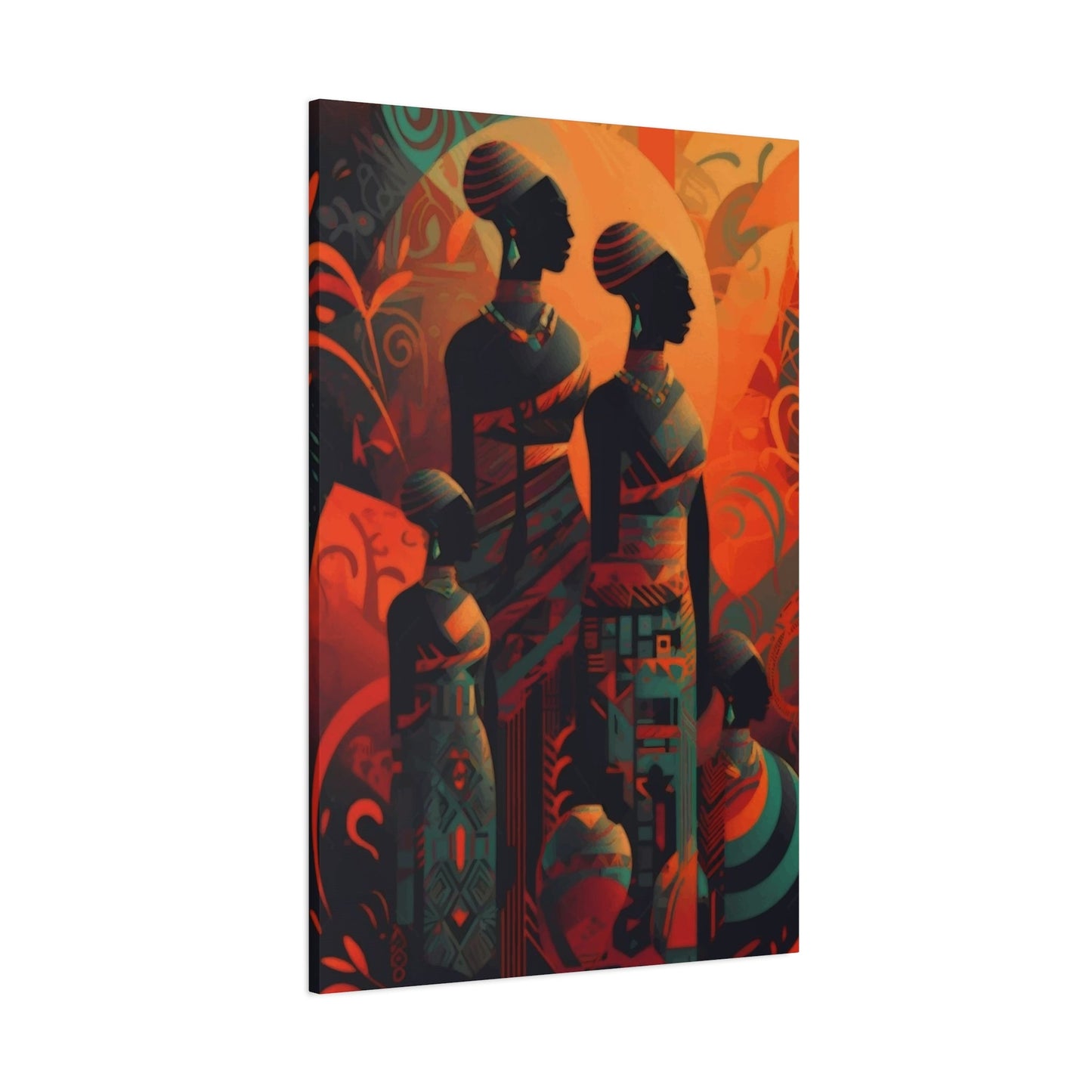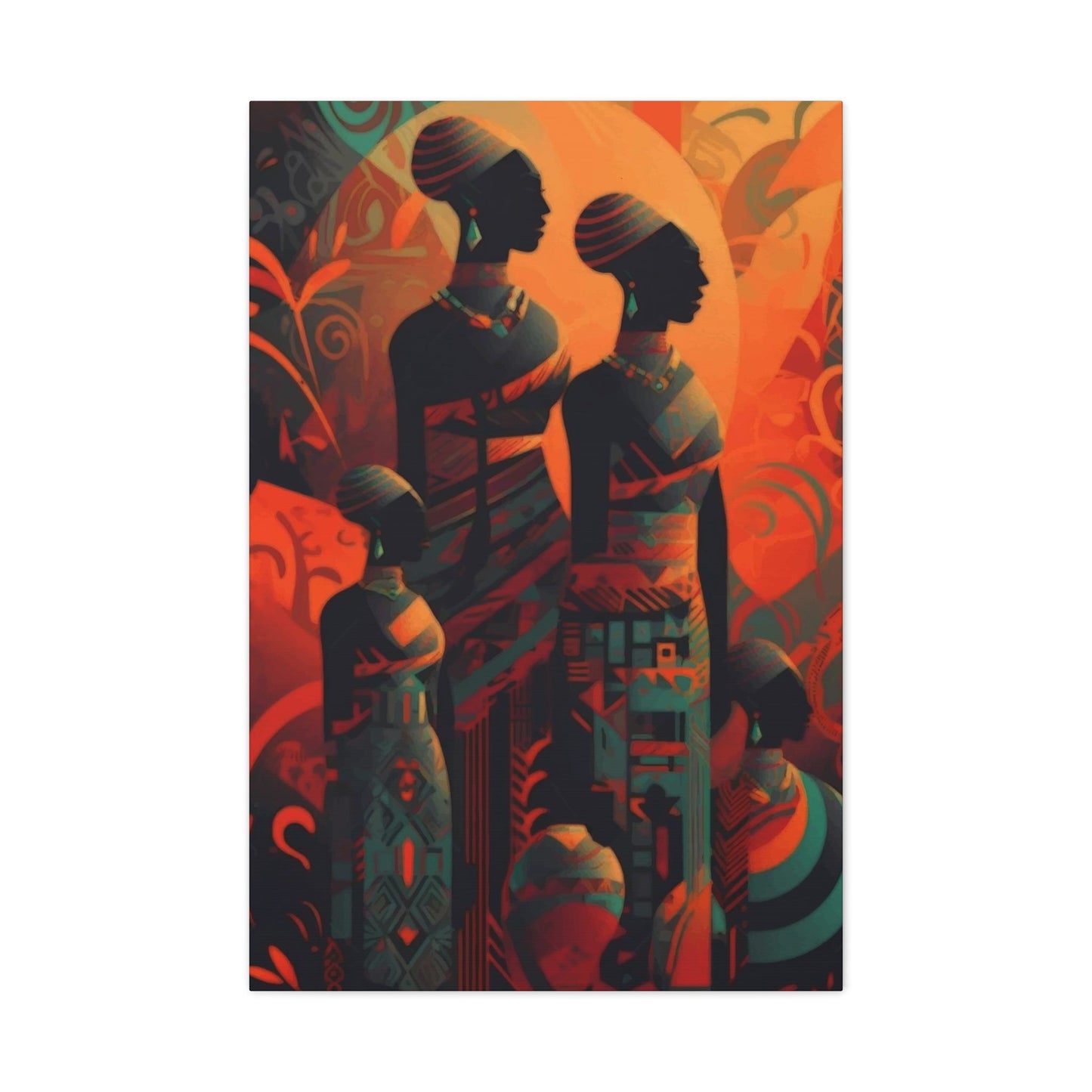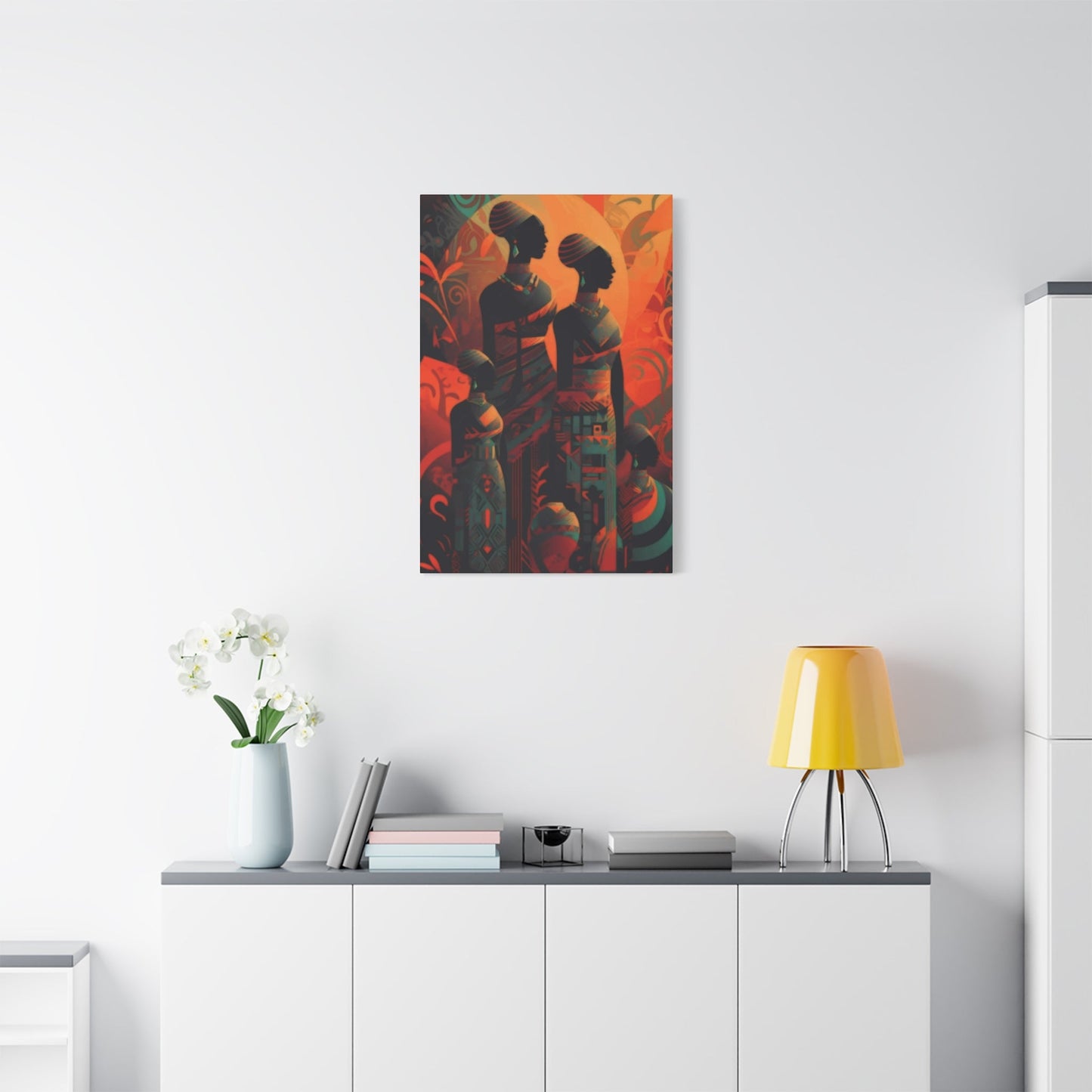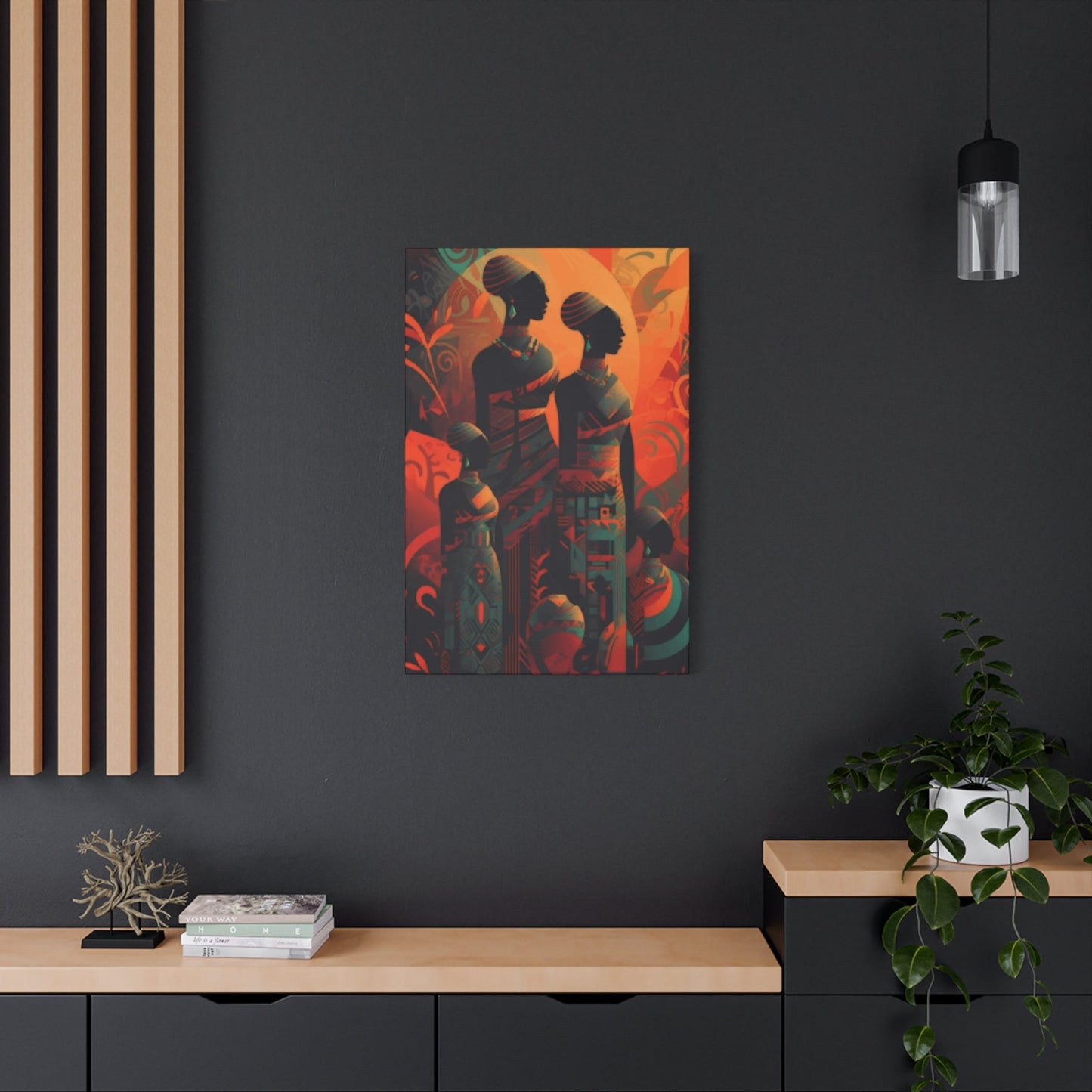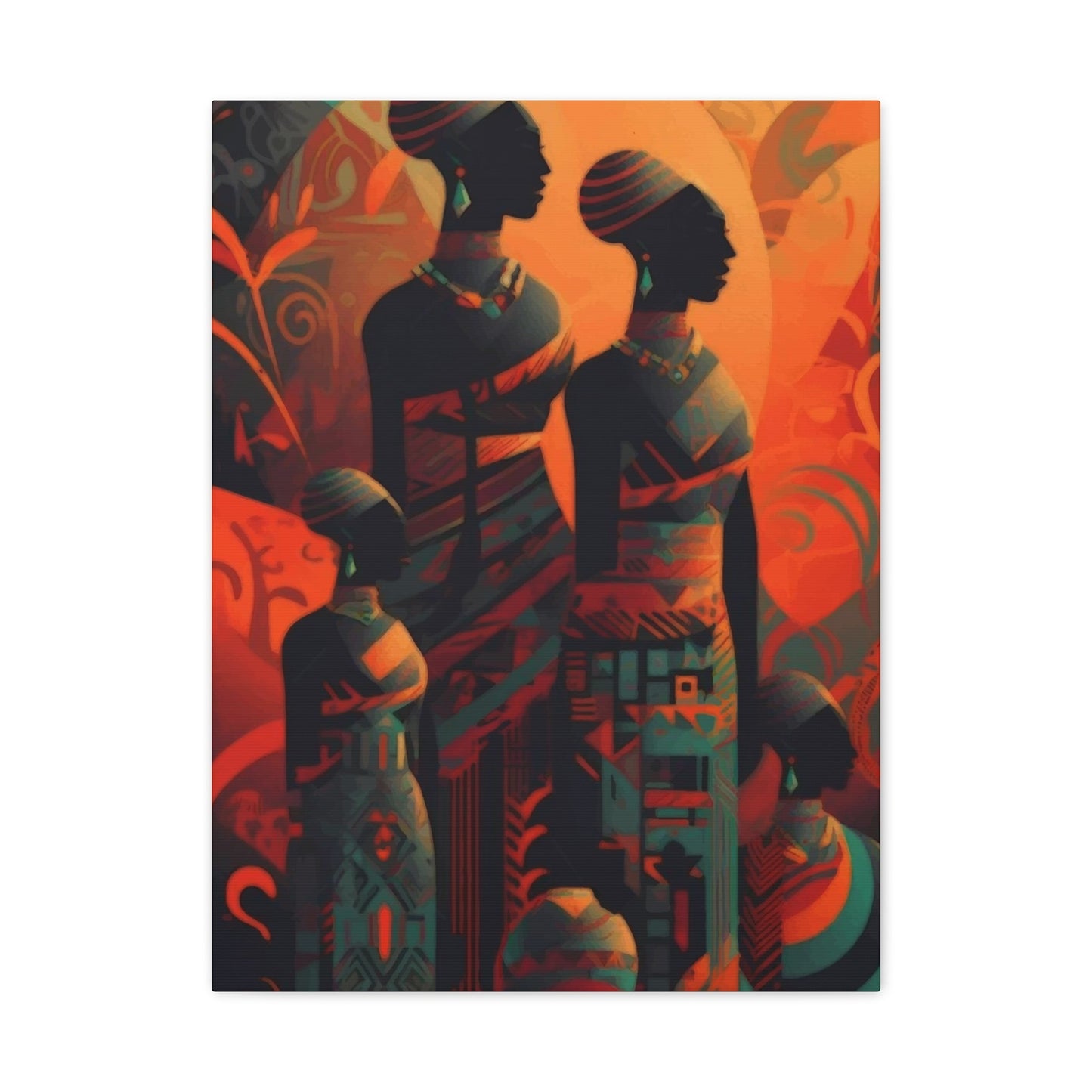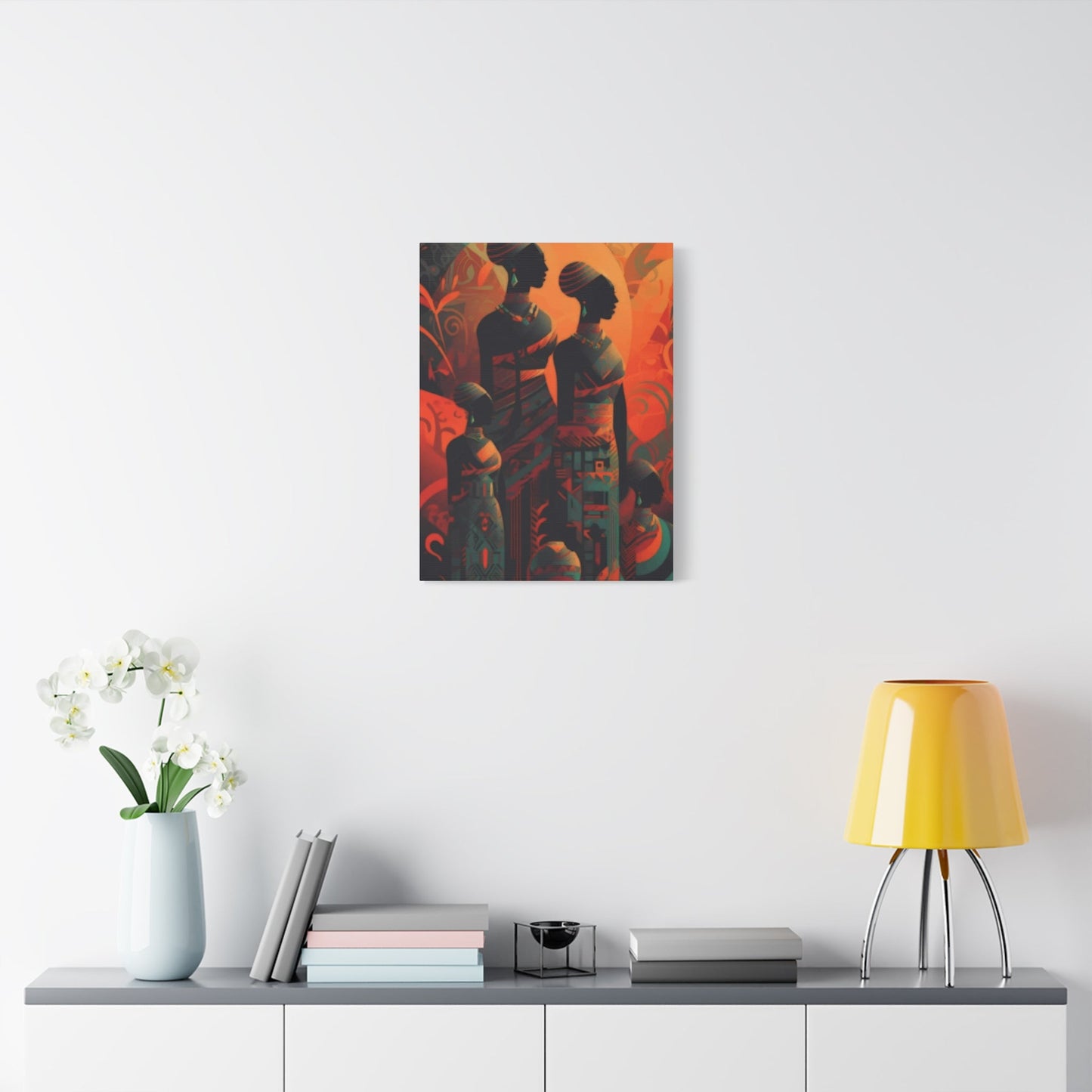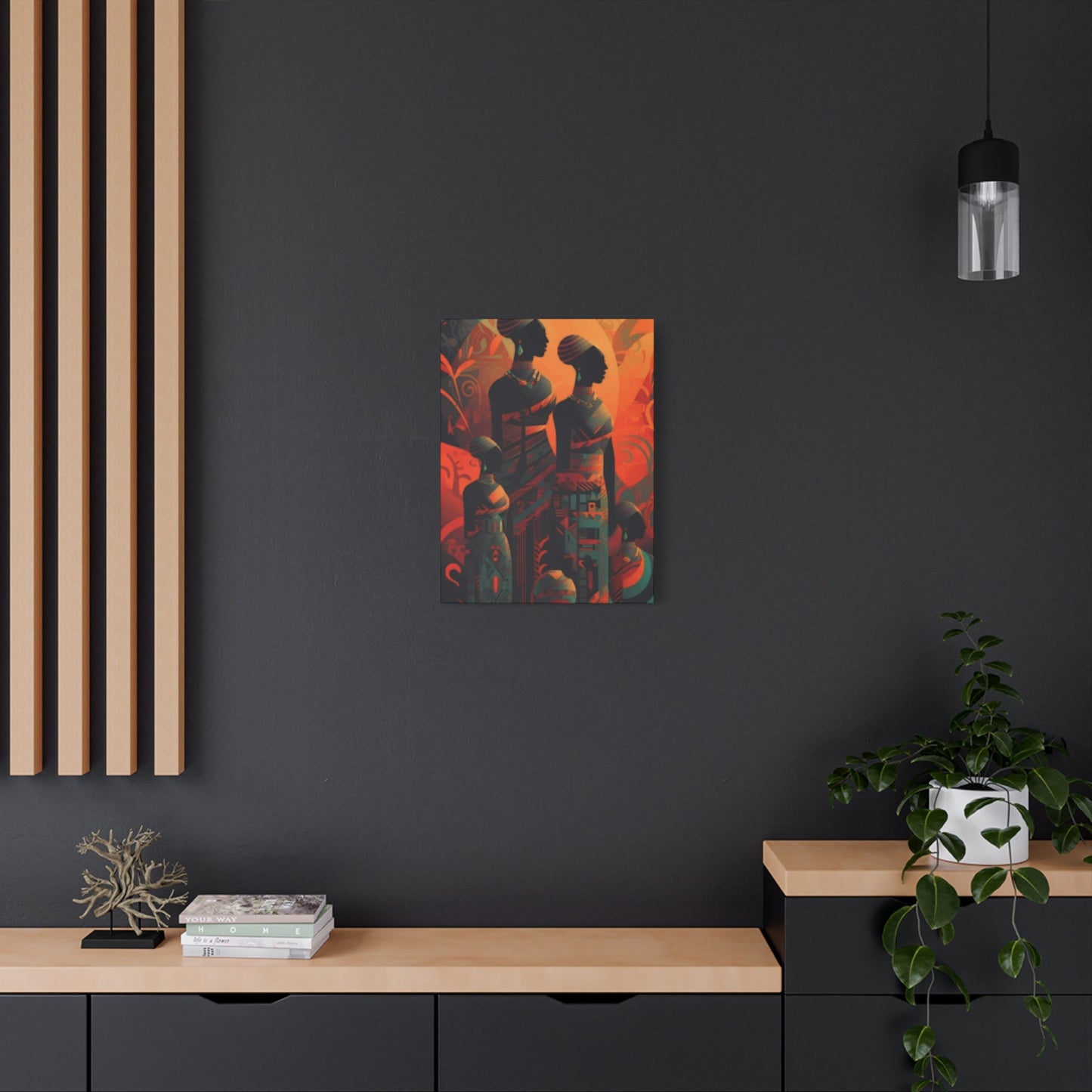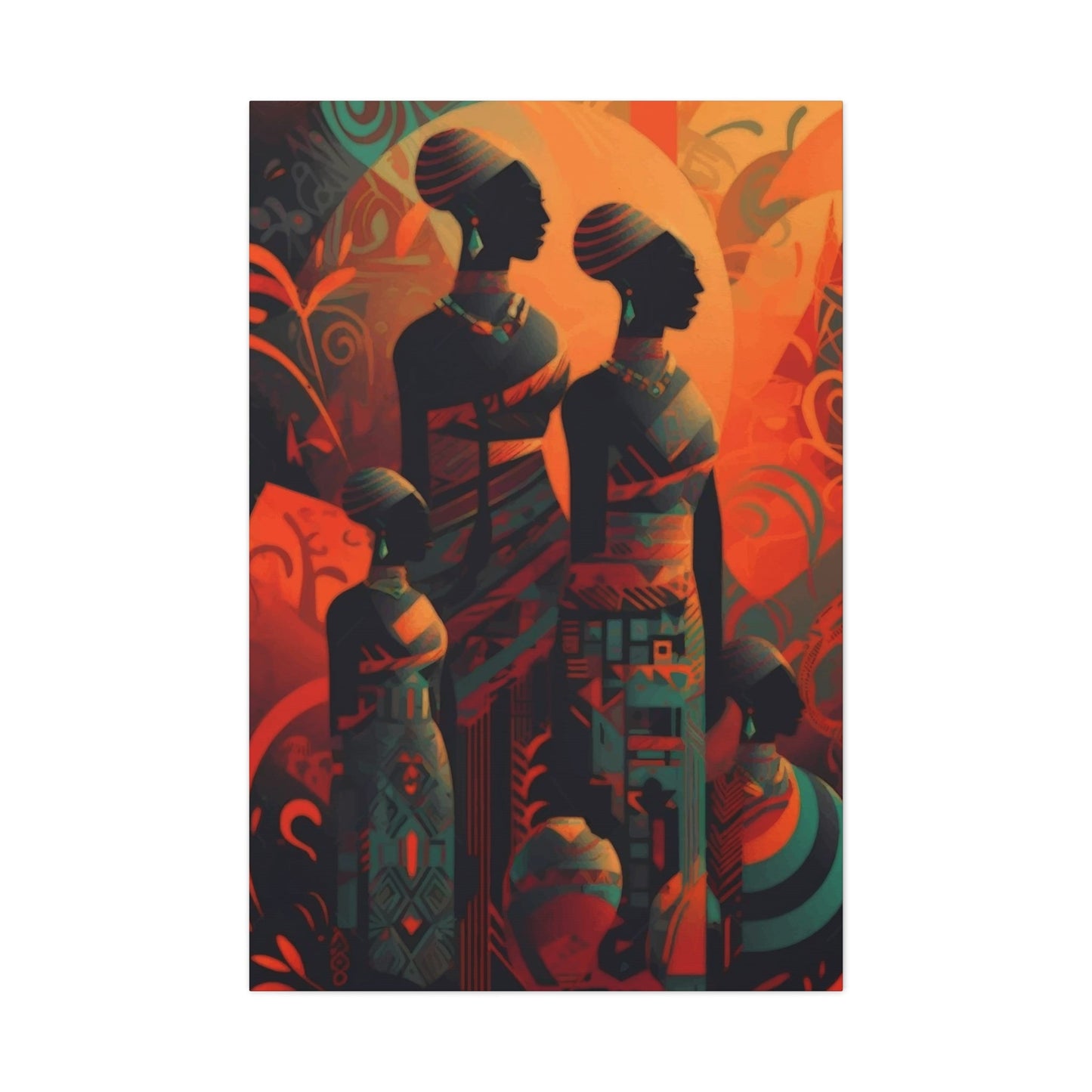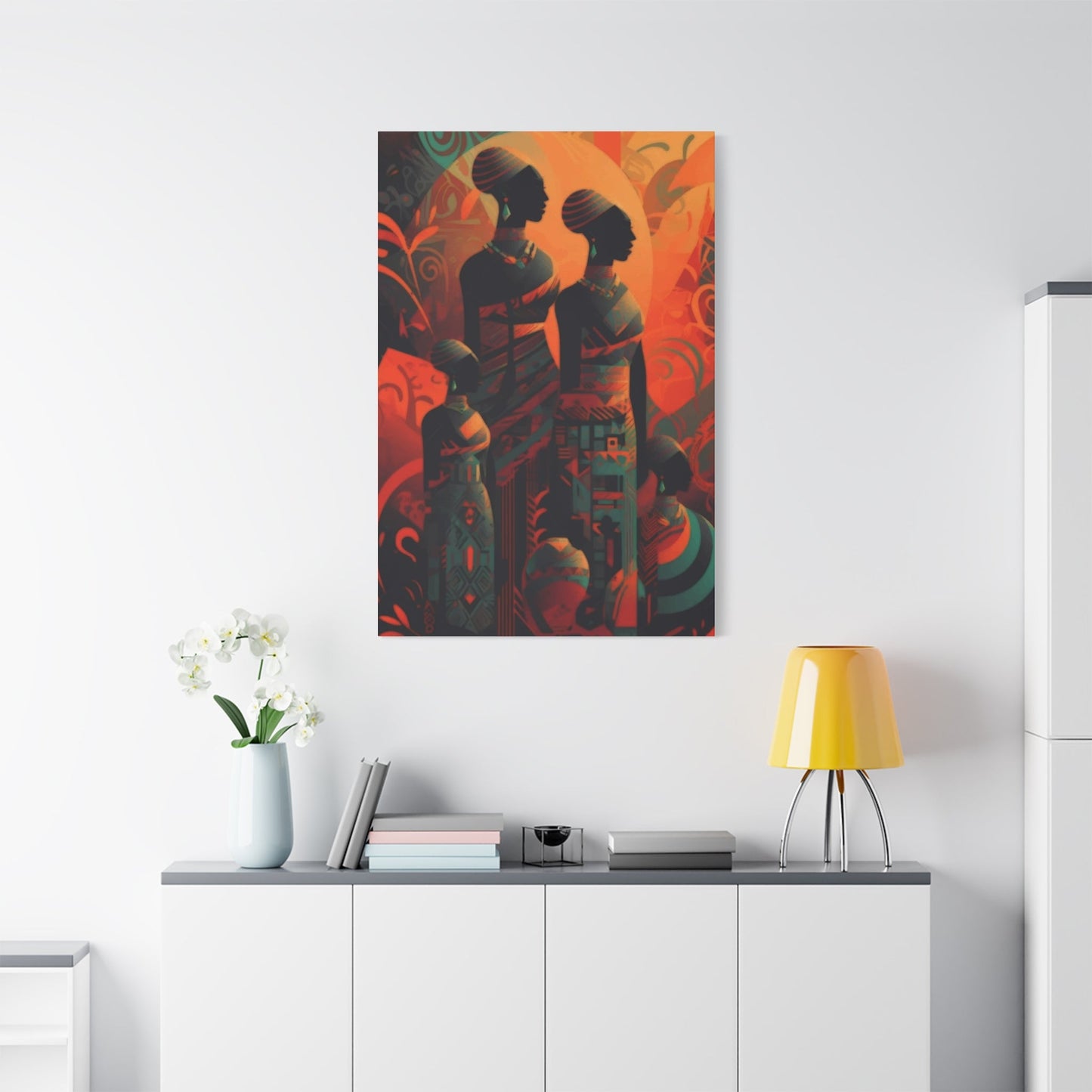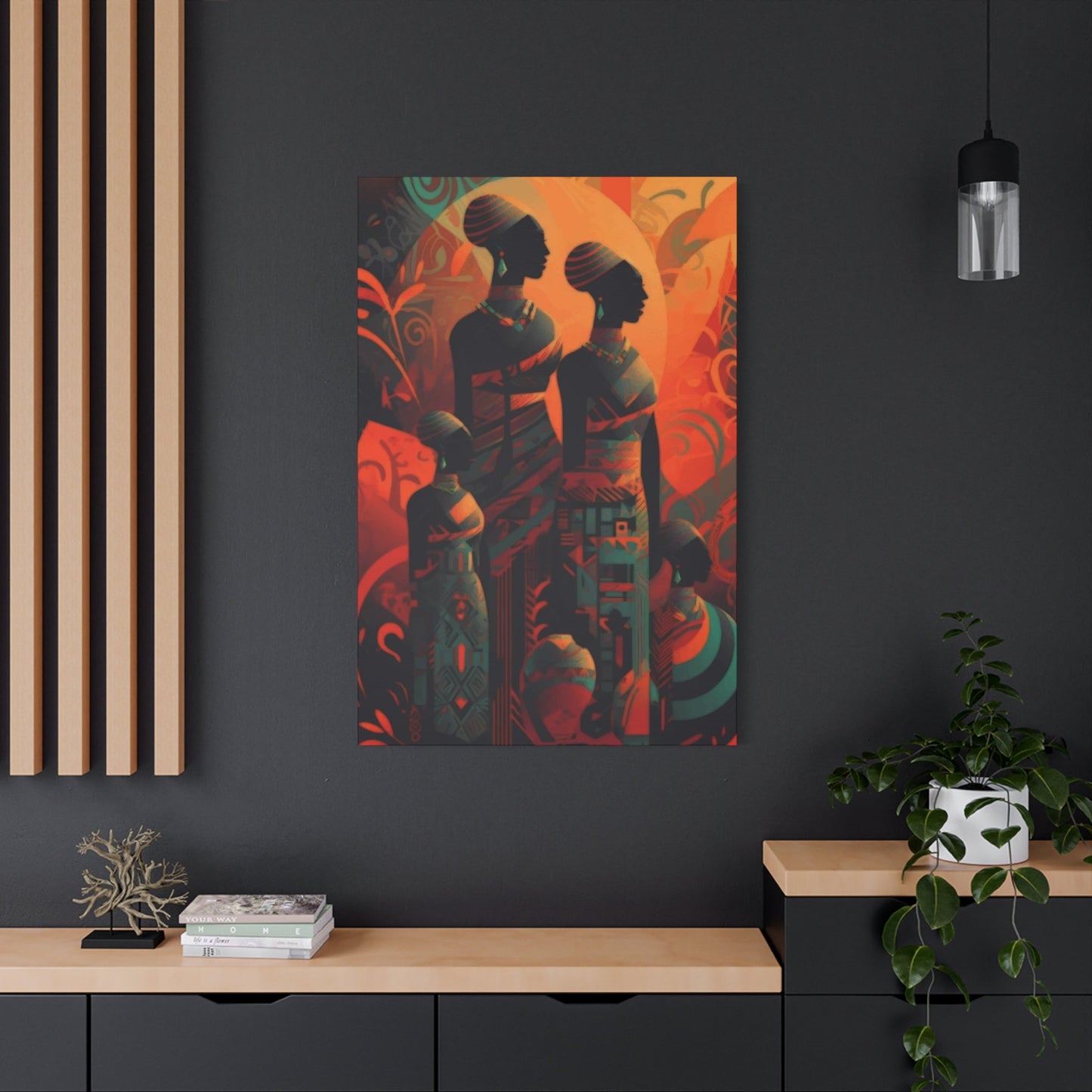Celebrating Heritage: African Tribe Wall Art That Bring Culture to Life
African tribal visual expressions have captivated art enthusiasts and interior designers worldwide, offering a powerful way to transform living spaces with rich cultural heritage and striking aesthetic appeal. These magnificent pieces serve as windows into ancient civilizations, showcasing the profound artistic traditions that have flourished across the African continent for millennia. The intricate patterns, vibrant colors, and symbolic representations found in tribal visual expressions create an atmosphere of warmth, authenticity, and cultural depth that resonates with contemporary design sensibilities.
The growing popularity of these decorative elements reflects a broader appreciation for cultural diversity and authentic artistic expression in modern interior design. Homeowners increasingly seek meaningful decor that tells a story, connects them to different cultures, and creates conversation-worthy focal points within their living spaces. African tribal visual expressions perfectly fulfill these desires while offering unparalleled versatility in terms of style integration and spatial application.
Discover the Beauty of African Tribe Wall Art
The mesmerizing world of African tribal visual expressions encompasses an extraordinary range of artistic styles, each reflecting the unique cultural identity and historical experiences of different tribal communities. From the bold geometric patterns of the Ndebele people to the intricate mask designs of West African cultures, these artistic creations represent centuries of creative evolution and cultural storytelling. The visual language employed in these works speaks to universal human experiences while maintaining distinctly African characteristics that make them instantly recognizable and deeply meaningful.
Understanding the beauty of these artistic expressions requires appreciation for the sophisticated symbolism embedded within each piece. Many designs incorporate representations of animals, natural elements, and spiritual concepts that hold profound significance within their originating communities. Lions symbolize strength and leadership, elephants represent wisdom and memory, while intricate patterns often convey messages about community relationships, seasonal cycles, or spiritual beliefs. This layered meaning transforms simple decorative pieces into powerful cultural artifacts that enrich any interior environment.
The color palettes traditionally employed in African tribal visual expressions draw inspiration from the natural world, incorporating earth tones, vibrant reds, deep blues, and striking yellows that reflect the diverse landscapes of the African continent. These color combinations create visual harmony while maintaining enough contrast to generate dynamic visual interest. The masterful use of color in these artistic traditions demonstrates sophisticated understanding of visual psychology and aesthetic principles that continue to influence contemporary design practices.
Contemporary interpretations of traditional tribal designs have evolved to meet modern aesthetic preferences while maintaining respect for cultural authenticity. Artists and designers work carefully to honor traditional motifs while adapting them for contemporary spaces, ensuring that cultural integrity remains intact throughout the creative process. This thoughtful approach has resulted in a rich variety of options that allow homeowners to incorporate meaningful cultural elements into their decor without compromising their personal design vision or cultural sensitivity.
The craftsmanship evident in quality African tribal visual expressions reflects generations of artistic expertise and cultural transmission. Traditional methods of pattern creation, color application, and symbolic representation continue to inform contemporary production, ensuring that modern pieces maintain the authentic spirit and artistic quality of their historical predecessors. This commitment to traditional craftsmanship standards guarantees that each piece carries the cultural weight and artistic integrity that makes African tribal visual expressions so compelling and meaningful.
How to Choose African Tribe Canvas Prints for Your Home
Selecting the perfect African tribal canvas prints for your living space requires careful consideration of multiple factors that will influence both the aesthetic impact and cultural appropriateness of your choices. The process begins with understanding your existing interior design scheme and identifying opportunities where tribal visual expressions can enhance rather than compete with your current decor. This strategic approach ensures that your new additions will integrate seamlessly while creating the desired visual impact and cultural depth.
Room size and layout considerations play crucial roles in determining the appropriate scale and placement of tribal canvas prints. Large, open spaces can accommodate oversized pieces or multiple coordinated works that create dramatic focal points, while smaller rooms benefit from carefully chosen pieces that add visual interest without overwhelming the available space. Consider the viewing angles and natural light sources within each room, as these factors will significantly influence how the colors and details of your chosen pieces will appear throughout different times of day.
Color coordination represents another essential aspect of the selection process, requiring careful analysis of your existing color scheme and identification of complementary or contrasting elements within potential tribal prints. The rich, earthy tones common in African tribal visual expressions often harmonize beautifully with neutral color schemes while providing striking accents in more colorful environments. Consider how the dominant colors in your prospective prints will interact with existing furniture, textiles, and architectural elements to create cohesive visual flow throughout your space.
The cultural significance and authenticity of your chosen pieces deserve careful consideration to ensure respectful representation of African tribal traditions. Research the cultural context behind specific designs and patterns to develop appreciation for their meaning and significance within their originating communities. This knowledge enhances your personal connection to the pieces while ensuring that your selections demonstrate cultural awareness and respect rather than superficial appropriation.
Quality considerations encompass both the artistic merit of the designs and the technical aspects of canvas production and printing. High-quality canvas prints feature vibrant, fade-resistant inks applied to durable canvas materials that will maintain their appearance over time. Examine the resolution and clarity of printed details, ensuring that intricate patterns and subtle color variations are accurately reproduced. Professional mounting and framing options can significantly enhance the presentation and longevity of your chosen pieces.
Budget planning allows for strategic purchasing decisions that maximize the impact of your investment while ensuring long-term satisfaction with your choices. Consider purchasing fewer, higher-quality pieces rather than multiple lower-quality options, as superior craftsmanship and materials will provide better value over time. Many retailers offer sets or collections that provide coordinated options at favorable pricing, making it possible to create comprehensive design schemes without exceeding budget constraints.
Top Trends in African Tribe Wall Art & Canvas Prints
The contemporary market for African tribal visual expressions reflects evolving design preferences that blend traditional cultural elements with modern aesthetic sensibilities. Current trends emphasize larger-scale pieces that serve as dramatic focal points within contemporary interiors, moving away from smaller, supplementary decorative elements toward statement pieces that anchor entire room designs. This shift reflects growing confidence in incorporating bold cultural elements and recognition of the powerful visual impact that substantial tribal prints can create within modern living spaces.
Monochromatic and limited color palette interpretations have gained significant popularity among design-conscious consumers who appreciate the cultural significance of tribal patterns while preferring more subdued color schemes. These refined approaches maintain the geometric complexity and symbolic richness of traditional designs while adapting the visual presentation to complement minimalist and contemporary interior styles. Black and white interpretations, sepia-toned variations, and single-color treatments offer sophisticated alternatives that preserve cultural authenticity while meeting modern aesthetic preferences.
Mixed media presentations combining traditional canvas printing with three-dimensional elements, metallic accents, or textural enhancements represent exciting developments in contemporary tribal visual expression presentation. These innovative approaches add depth and tactile interest while maintaining respect for traditional design elements. Embossed details, metallic highlights, and layered presentations create engaging visual experiences that draw viewers closer and encourage detailed examination of cultural symbols and artistic craftsmanship.
Customization and personalization options have expanded significantly, allowing consumers to adapt traditional tribal designs to their specific spatial requirements and aesthetic preferences. Custom sizing, color modification, and compositional adjustments make it possible to incorporate meaningful tribal visual expressions into virtually any interior environment while maintaining cultural integrity and artistic quality. This flexibility has made tribal prints accessible to broader audiences and applicable to diverse design contexts.
Digital enhancement and high-definition reproduction capabilities have revolutionized the quality and accessibility of tribal canvas prints, making museum-quality reproductions available to residential consumers. Advanced printing technologies capture subtle details, color variations, and textural elements that were previously lost in standard reproduction processes. These improvements ensure that contemporary tribal prints maintain the visual impact and cultural authenticity of their traditional inspirations.
Sustainable and ethically-sourced options have become increasingly important to conscious consumers who value both cultural respect and environmental responsibility. Many producers now offer eco-friendly canvas materials, water-based inks, and sustainable production processes that minimize environmental impact while supporting ethical business practices. These options allow consumers to incorporate meaningful cultural elements into their homes while aligning with their personal values regarding sustainability and social responsibility.
Decorating with African Tribe Art: Tips and Ideas
Creating successful interior designs incorporating African tribal visual expressions requires understanding how these powerful cultural elements interact with various design styles and spatial configurations. The key lies in achieving balance between the bold visual impact of tribal prints and the overall harmony of your interior environment. Start by identifying natural focal points within your rooms where tribal pieces can command attention without competing with architectural features or existing design elements.
Layering different scales and styles of tribal visual expressions creates depth and visual interest while maintaining cultural coherence. Combine larger statement pieces with smaller complementary works, mixing different tribal traditions and artistic approaches to create rich, diverse presentations that reflect the breadth of African cultural expression. This approach prevents monotony while demonstrating appreciation for the diversity of African artistic traditions and their unique cultural contributions.
Lighting considerations significantly influence the presentation and impact of tribal visual expressions within interior spaces. Natural light enhances the organic colors and earth tones common in traditional tribal designs, while strategic artificial lighting can highlight specific details and create dramatic shadow effects that emphasize geometric patterns and symbolic elements. Consider installing adjustable lighting systems that allow you to modify the presentation of your tribal pieces according to different occasions and times of day.
Furniture selection and placement should complement rather than compete with tribal visual expressions, creating supportive environments that enhance the cultural impact of these meaningful pieces. Natural materials like wood, leather, and woven textiles harmonize beautifully with tribal prints, while clean-lined contemporary furniture provides neutral backgrounds that allow cultural elements to shine. Avoid overly ornate or competing decorative elements that might diminish the impact of your tribal visual expressions.
Textile coordination offers opportunities to extend tribal themes throughout your interior spaces while creating cohesive design narratives. Incorporate complementary fabrics, rugs, and soft furnishings that echo the colors, patterns, or cultural themes present in your tribal prints without creating exact matches that appear overly coordinated. This subtle approach creates visual connections while maintaining design sophistication and cultural authenticity.
Seasonal adaptation allows you to modify the presentation and impact of tribal visual expressions according to changing preferences and occasions. Adjust surrounding accessories, lighting, and complementary elements to highlight different aspects of your tribal pieces throughout the year. This dynamic approach keeps your interior design fresh and engaging while maximizing your investment in meaningful cultural elements.
Why African Tribe Canvas Prints Make Bold Statements
The inherent power of African tribal visual expressions lies in their ability to communicate complex cultural concepts through sophisticated visual languages that transcend linguistic barriers. These artistic creations carry the weight of centuries of cultural development, spiritual belief systems, and community identity, making them naturally compelling focal points within any interior environment. The bold geometric patterns, symbolic representations, and cultural narratives embedded in tribal designs create immediate visual impact while inviting deeper contemplation and cultural appreciation.
The psychological impact of tribal visual expressions stems from their connection to fundamental human experiences and universal cultural themes. The patterns and symbols commonly found in African tribal designs resonate with deep-seated psychological responses to geometric harmony, natural forms, and cultural storytelling. These elements trigger emotional connections that go beyond simple aesthetic appreciation, creating meaningful relationships between viewers and the cultural heritage represented in the visual expressions.
Scale and proportion play crucial roles in the statement-making potential of tribal canvas prints, with larger pieces commanding greater attention and creating more dramatic environmental impacts. Oversized tribal prints transform entire walls into cultural showcases, while strategically placed medium-sized pieces create focal points that draw attention without overwhelming surrounding elements. The bold nature of tribal designs means that even smaller pieces can make significant visual statements when properly positioned and presented.
The contrast between traditional tribal elements and contemporary interior environments creates dynamic tension that generates visual excitement and cultural dialogue. This juxtaposition highlights the timeless relevance of African cultural expressions while demonstrating how traditional art forms can enhance and enliven modern living spaces. The successful integration of tribal prints with contemporary design elements showcases cultural appreciation and design sophistication while creating unique, personalized interior environments.
Color intensity and symbolic richness contribute to the bold nature of tribal visual expressions, with traditional palettes offering striking alternatives to conventional neutral design schemes. The deep reds, vibrant yellows, and rich earth tones commonly found in tribal designs create warm, inviting atmospheres while making definitive style statements. These colors work particularly well in contemporary settings where they provide organic warmth and cultural depth that balance the clean lines and neutral tones of modern design.
The conversation-starting potential of tribal visual expressions makes them ideal choices for social spaces where their cultural significance and artistic merit can be appreciated and discussed. These pieces naturally invite questions about their origins, meanings, and cultural contexts, creating opportunities for meaningful conversations about cultural diversity, artistic traditions, and personal design choices. This social dimension adds value beyond simple aesthetic appeal, making tribal prints worthwhile investments in both design and cultural education.
Mixing African Tribe Wall Art with Modern Decor
The successful integration of African tribal visual expressions with contemporary design elements requires understanding how cultural authenticity can enhance rather than conflict with modern aesthetic principles. The key lies in identifying complementary aspects of both design approaches and creating harmonious relationships that respect cultural integrity while achieving contemporary sophistication. Modern minimalist environments often provide ideal backdrops for tribal prints, allowing these cultural elements to command appropriate attention while benefiting from the clean, uncluttered presentations that contemporary design provides.
Material coordination offers practical approaches to blending tribal visual expressions with modern decor elements. The natural materials common in tribal designs work beautifully with contemporary preferences for authentic, sustainable materials. Wood, metal, glass, and natural fiber elements can bridge the gap between traditional tribal aesthetics and modern design sensibilities, creating cohesive environments that feel both culturally rich and contemporarily relevant.
Geometric pattern relationships provide another avenue for successful integration, as many modern design elements incorporate geometric forms that echo traditional tribal patterns. Contemporary furniture with clean lines, angular shapes, and geometric details can complement the sophisticated pattern work found in African tribal visual expressions. This approach creates visual dialogue between traditional and contemporary elements while maintaining design coherence throughout the space.
Color temperature considerations help balance the warm, earthy tones common in tribal prints with the cooler tones often preferred in contemporary design schemes. Strategic use of neutral bridge colors, careful lighting selection, and thoughtful accessory choices can harmonize these different color approaches while maintaining the integrity of both design styles. This balanced approach prevents either element from overwhelming the other while creating rich, layered visual experiences.
Spatial organization principles drawn from contemporary design can enhance the presentation and impact of tribal visual expressions within modern interiors. Clean sight lines, strategic negative space, and carefully planned focal points help tribal prints achieve maximum impact within contemporary environments. This approach demonstrates how modern design principles can support and enhance traditional cultural elements rather than competing with them.
Accessory selection offers opportunities to create subtle connections between tribal and contemporary elements without creating obvious or heavy-handed coordination. Modern accessories with natural materials, geometric forms, or cultural themes can echo elements found in tribal prints while maintaining contemporary sophistication. This nuanced approach creates rich, layered designs that feel both culturally aware and aesthetically current.
Creating a Gallery Wall with African Tribe Canvas Prints
Planning and executing successful gallery wall installations featuring African tribal visual expressions requires careful consideration of compositional principles, cultural coherence, and visual flow. The process begins with understanding the available wall space and developing layout concepts that maximize the impact of individual pieces while creating unified presentations that showcase the diversity and richness of African tribal artistic traditions. Gallery walls offer excellent opportunities to combine different tribal styles, scales, and cultural origins while maintaining visual coherence through thoughtful planning and strategic execution.
Composition planning involves creating balanced arrangements that distribute visual weight evenly while establishing clear focal points and directional flow. Start by identifying your strongest or most significant tribal piece and use it as an anchor around which other elements can be arranged. Consider the visual relationships between different pieces, ensuring that colors, patterns, and scales work together harmoniously while maintaining enough contrast to keep the arrangement visually interesting and dynamic.
Scale variation within gallery wall arrangements creates visual rhythm and prevents monotonous presentations that fail to engage viewers effectively. Combine larger statement pieces with medium-sized works and smaller detailed pieces to create dynamic compositions that guide the eye through the arrangement while highlighting different aspects of tribal artistic expression. This approach demonstrates the range and diversity of African tribal visual traditions while creating engaging viewing experiences.
Cultural coordination ensures that your gallery wall arrangement respects the diverse traditions represented in African tribal visual expressions while creating coherent presentations that celebrate this diversity appropriately. Research the cultural origins of your chosen pieces to understand their relationships and avoid combinations that might be culturally inappropriate or historically inaccurate. This knowledge enhances the educational value of your gallery wall while demonstrating cultural awareness and respect.
Spacing and alignment considerations significantly influence the success of gallery wall installations, with precise measurements and careful planning preventing common mistakes that diminish overall impact. Maintain consistent spacing between pieces while allowing each work adequate breathing room to be appreciated individually. Consider the eye level of primary viewers and adjust the height of your arrangement accordingly to ensure comfortable viewing angles and maximum visual impact.
Installation planning involves careful preparation and precise execution to achieve professional-quality results that enhance rather than detract from your tribal visual expressions. Use proper hardware appropriate for the weight and size of your pieces, and consider professional installation for valuable or particularly heavy works. Plan the installation process carefully to minimize wall damage and ensure that adjustments can be made easily if the initial layout requires modification.
Affordable Ways to Add African Tribe Wall Art to Your Space
Budget-conscious approaches to incorporating African tribal visual expressions into interior spaces require creativity, strategic planning, and knowledge of available resources that provide access to authentic cultural elements without excessive financial investment. The key lies in identifying cost-effective sources for quality pieces while developing design strategies that maximize impact through careful selection and strategic placement rather than expensive acquisition of numerous works.
Print-on-demand services offer accessible entry points for exploring African tribal visual expressions, providing high-quality reproductions of traditional designs at affordable prices. These services often offer customization options that allow you to adjust sizes, color schemes, and presentation formats to meet your specific spatial requirements and budget constraints. Research providers carefully to ensure they offer authentic designs created with cultural sensitivity and respect for traditional artistic traditions.
DIY framing and presentation options can significantly reduce the total cost of incorporating tribal prints into your interior design while providing opportunities for creative customization. Simple, clean frames often enhance rather than compete with bold tribal designs, and basic framing supplies are readily available at affordable prices. Consider creating your own mounting solutions using quality materials and techniques that provide professional-appearing results without professional pricing.
Seasonal sales and promotional opportunities provide access to higher-quality pieces at reduced prices, making it possible to acquire authentic tribal visual expressions that might otherwise exceed budget constraints. Many retailers offer significant discounts during specific seasons or promotional periods, and subscribing to newsletters or following social media accounts can provide advance notice of upcoming sales opportunities.
Group purchasing arrangements with friends, family members, or colleagues can provide access to bulk pricing or wholesale opportunities that reduce individual costs while expanding selection options. Coordinate with others who share interest in African tribal visual expressions to identify shared purchasing opportunities that benefit all participants. This approach works particularly well for related pieces or coordinated sets that can be divided among multiple buyers.
Alternative presentation methods can reduce costs while creating unique, personalized displays that showcase tribal visual expressions creatively. Consider using clip systems, rail mounting, or temporary adhesive solutions that eliminate framing costs while providing flexibility for rearrangement and experimentation. These approaches work particularly well in casual spaces or rental situations where permanent installation options may be limited.
Exploring African Tribe Culture Through Canvas Prints
African tribal visual expressions serve as powerful windows into diverse cultural traditions that span centuries of human development and artistic evolution. Each piece carries embedded cultural knowledge that extends far beyond simple aesthetic appeal, offering insights into belief systems, social structures, historical experiences, and community values that continue to shape African societies today. Understanding these cultural dimensions transforms simple decorative purchases into meaningful educational investments that enrich personal knowledge while supporting cultural preservation and appreciation.
Symbolic interpretation requires developing familiarity with the visual languages employed by different African tribal communities to convey complex cultural concepts through artistic expression. Animals, geometric patterns, natural elements, and abstract symbols all carry specific meanings that vary between different tribal traditions and geographical regions. Lions represent leadership and courage, elephants symbolize wisdom and memory, while specific geometric patterns may indicate community relationships, seasonal cycles, or spiritual beliefs that are central to tribal identity and cultural continuity.
Regional variations reflect the incredible diversity of African tribal cultures and the unique environmental, historical, and social factors that have influenced artistic development across different geographical areas. West African designs often feature bold masks and ceremonial representations, while East African traditions emphasize animal symbolism and natural elements reflecting local wildlife and landscapes. Southern African cultures contribute sophisticated geometric patterns and earth-tone palettes that reflect their unique cultural perspectives and artistic traditions.
Historical context provides essential background for understanding how African tribal visual expressions have evolved in response to changing social, political, and economic conditions throughout history. Colonial influences, migration patterns, trade relationships, and cultural exchange have all shaped the development of tribal artistic traditions while communities have worked to maintain cultural authenticity and identity despite external pressures and changes.
Contemporary relevance demonstrates how traditional tribal visual expressions continue to influence modern African art and cultural expression while maintaining connections to historical traditions and cultural values. Many contemporary African artists draw inspiration from traditional tribal designs while adapting them to address current social issues and cultural challenges. This ongoing evolution demonstrates the vitality and relevance of tribal artistic traditions in contemporary African societies.
Cultural preservation efforts supported by the appreciation and purchase of tribal visual expressions contribute to ongoing efforts to maintain and protect African cultural heritage for future generations. By demonstrating market demand for authentic tribal designs and supporting ethical producers who respect cultural traditions, consumers participate in cultural preservation while enriching their own understanding and appreciation of African artistic heritage.
African Tribe Canvas Prints for Small Spaces
Maximizing the impact of African tribal visual expressions within limited spatial environments requires strategic selection and placement decisions that optimize visual effect while respecting spatial constraints. Small spaces actually offer unique advantages for tribal prints, as the intimate scale creates opportunities for detailed appreciation and meaningful cultural connection that might be lost in larger environments. The key lies in choosing appropriately scaled pieces and utilizing design principles that enhance rather than overwhelm compact living areas.
Scale selection becomes crucial in small spaces where oversized pieces can dominate environments and make rooms feel even smaller than their actual dimensions. Medium-sized tribal prints often work best in compact spaces, providing sufficient visual impact to create meaningful focal points without overwhelming the available area. Consider the viewing distances within your space and select pieces with appropriate detail levels that can be appreciated from typical viewing positions.
Vertical emphasis can help small spaces feel larger while providing ideal presentation opportunities for tribal visual expressions with strong vertical orientations. Many traditional tribal designs feature vertical compositional elements that work well with this spatial strategy, creating upward visual movement that enhances the perceived height of compact rooms. This approach works particularly well in narrow spaces where horizontal elements might emphasize spatial limitations.
Multi-functional integration allows tribal prints to serve both aesthetic and practical purposes within space-conscious environments. Consider incorporating tribal visual expressions into room dividers, storage solutions, or other functional elements that maximize spatial efficiency while providing cultural enrichment. This approach demonstrates how meaningful design elements can enhance rather than compromise functional requirements in small spaces.
Light interaction becomes particularly important in compact spaces where tribal prints can help manipulate perceived spatial dimensions through strategic color and pattern choices. Lighter backgrounds and warm colors can help small spaces feel more open and inviting, while carefully chosen tribal prints can add depth and visual interest without creating cramped or cluttered impressions. Consider how natural and artificial light sources will interact with your chosen pieces throughout different times of day.
Corner utilization and alternative placement strategies can help incorporate meaningful tribal visual expressions into small spaces without compromising traffic flow or functional requirements. Consider diagonal arrangements, corner-focused installations, or creative mounting solutions that take advantage of underutilized areas while creating surprising and engaging visual experiences. These approaches demonstrate how thoughtful placement can overcome spatial limitations while maintaining design impact.
How Artists Capture African Tribe Life in Wall Art
Contemporary artistic interpretations of African tribal life require delicate balance between cultural authenticity and creative expression, demanding deep understanding of traditional customs, daily practices, and spiritual beliefs that define tribal communities. Artists who successfully capture these cultural elements in visual form demonstrate respect for traditional knowledge while translating complex cultural concepts into accessible visual languages that can be appreciated by diverse audiences without compromising cultural integrity or perpetuating harmful stereotypes.
Research and cultural immersion provide essential foundations for authentic artistic representation of African tribal life, requiring artists to develop genuine understanding of the communities and traditions they choose to portray. This process involves studying historical sources, engaging with cultural experts, and sometimes collaborating directly with tribal communities to ensure accurate and respectful representation. The most successful artists approach these subjects as students rather than interpreters, allowing cultural knowledge to inform their creative processes.
Visual storytelling methods employed in tribal life representations often incorporate multiple layers of meaning and cultural reference that reward detailed examination and cultural knowledge. Artists may combine realistic portraiture with symbolic elements, traditional patterns, or ceremonial objects to create complex narratives that communicate cultural values, historical experiences, or spiritual beliefs. These multilayered approaches reflect the sophisticated storytelling traditions found within African tribal cultures themselves.
Composition strategies used to capture tribal life often emphasize community relationships, natural environments, and cultural practices that define tribal identity and social organization. Artists may choose to focus on ceremonial activities, daily work practices, family relationships, or community gatherings that illustrate the social cohesion and cultural continuity that characterize tribal communities. These compositional choices help viewers understand the context and significance of tribal cultural traditions.
Color palette selection reflects both the natural environments where tribal communities live and the symbolic color associations embedded within their cultural traditions. Earth tones, natural pigment colors, and traditional textile colors all play important roles in creating authentic visual representations while maintaining aesthetic appeal for contemporary audiences. Artists must balance historical accuracy with modern reproduction capabilities to achieve satisfactory results.
Technical execution involves mastering various artistic media and reproduction methods to achieve desired visual effects while maintaining cultural authenticity and artistic quality. Canvas printing, digital enhancement, and modern presentation methods must serve rather than overwhelm the cultural content being presented. The most successful pieces demonstrate technical proficiency while maintaining focus on cultural communication and artistic integrity.
The Best Materials for African Tribe Canvas Prints
Material selection significantly influences both the visual presentation and longevity of African tribal canvas prints, requiring careful consideration of factors including color reproduction accuracy, durability, texture, and environmental resistance. High-quality materials ensure that cultural investments maintain their aesthetic appeal and educational value over time while providing satisfaction worthy of the cultural significance represented in tribal visual expressions.
Canvas substrate options range from traditional cotton and linen materials to contemporary synthetic alternatives, each offering distinct advantages for different applications and budget requirements. Cotton canvas provides excellent color absorption and natural texture that complements the organic themes common in tribal designs, while linen offers superior durability and archival stability for long-term cultural preservation. Synthetic options may provide enhanced moisture resistance and consistent reproduction characteristics that benefit certain environmental conditions.
Ink quality and composition directly influence color vibrancy, fade resistance, and overall visual impact of tribal canvas prints. Premium pigment-based inks offer superior longevity and color accuracy compared to dye-based alternatives, ensuring that cultural investments maintain their visual impact over extended periods. UV-resistant formulations provide additional protection against environmental factors that could diminish color quality and cultural presentation value.
Coating and surface treatments can enhance durability while providing protection against environmental factors that threaten the longevity of tribal canvas prints. Protective coatings can resist moisture, dust, and handling damage while maintaining the visual accessibility necessary for cultural appreciation. Matte and semi-gloss options offer different aesthetic effects that can complement various presentation requirements and interior environments.
Mounting and support systems influence both presentation quality and structural integrity of tribal canvas prints, requiring attention to weight distribution, environmental stability, and installation requirements. Gallery-wrap mounting creates clean, professional presentations that emphasize the cultural content without distracting framework elements. Alternative mounting options may provide cost advantages or specialized installation capabilities that meet specific spatial requirements.
Environmental considerations including temperature stability, humidity resistance, and light sensitivity affect the placement and care requirements of tribal canvas prints. Understanding these factors helps ensure appropriate installation environments and maintenance practices that preserve cultural investments while maintaining their educational and aesthetic value. Quality materials reduce maintenance requirements while providing confidence in long-term cultural preservation.
African Tribe Canvas Prints as a Focal Point in Interiors
Strategic utilization of African tribal visual expressions as primary focal points requires understanding how these culturally rich elements can anchor interior design schemes while commanding appropriate attention and respect. Successful focal point implementations balance the bold visual impact of tribal prints with supporting design elements that enhance rather than compete with cultural presentation, creating harmonious environments that celebrate African artistic heritage while meeting contemporary aesthetic standards.
Positioning considerations involve identifying optimal locations where tribal prints can achieve maximum visual impact while maintaining comfortable viewing angles and appropriate cultural presentation. Primary walls, areas above significant furniture pieces, and natural sight line intersections often provide ideal focal point opportunities where tribal visual expressions can command attention without overwhelming spatial relationships or functional requirements.
Supporting element coordination ensures that furniture, accessories, and architectural features work together to enhance rather than diminish the impact of tribal focal points. Neutral backgrounds, complementary color schemes, and strategic lighting can all contribute to successful focal point presentations that honor cultural significance while achieving design objectives. This coordinated approach demonstrates how tribal visual expressions can elevate entire interior environments rather than simply decorating wall space.
Scale relationships between focal point tribal prints and surrounding elements require careful planning to achieve appropriate visual hierarchy and spatial balance. Oversized pieces demand substantial spatial commitment and supporting design decisions that acknowledge their dominant presence, while medium-sized focal points offer greater flexibility in supporting element selection and spatial arrangement. Understanding these relationships helps ensure successful design outcomes.
Cultural context presentation allows focal point tribal prints to serve educational as well as aesthetic functions within interior environments. Strategic placement near seating areas encourages closer examination and cultural appreciation, while appropriate lighting and complementary accessories can reinforce cultural themes and support meaningful cultural dialogue. This approach maximizes the value of cultural investments while demonstrating respect for African artistic heritage.
Seasonal adaptation strategies allow focal point tribal prints to maintain visual interest and cultural relevance throughout changing design preferences and environmental conditions. Adjustable supporting elements, lighting modifications, and accessory changes can refresh focal point presentations while maintaining cultural integrity and design coherence. This flexibility ensures long-term satisfaction with significant cultural investments.
DIY Ideas Inspired by African Tribe Wall Art
Creative interpretation of African tribal visual elements through do-it-yourself projects offers opportunities for personal expression while maintaining respect for cultural traditions and artistic heritage. Successful DIY approaches draw inspiration from traditional patterns, colors, and symbolic elements without attempting to replicate sacred or culturally sensitive designs that should remain within their original cultural contexts. This balanced approach allows creative exploration while demonstrating cultural awareness and respect.
Pattern adaptation involves studying traditional tribal geometric designs and developing personal interpretations that honor cultural origins while expressing individual creativity. Simple geometric patterns, color combinations, and compositional approaches can inspire original creations that reflect tribal aesthetic principles without appropriating specific cultural symbols or sacred designs. This approach fosters cultural appreciation while encouraging personal artistic development.
Color exploration based on traditional tribal palettes provides foundations for DIY projects that capture the warmth and vibrancy associated with African artistic traditions. Earth tones, natural pigment colors, and traditional textile combinations can inform personal color choices while creating visual connections to tribal heritage. Understanding color symbolism helps ensure respectful interpretation while providing creative inspiration.
Material experimentation using natural and sustainable materials reflects the environmental consciousness often found in traditional tribal cultures while providing opportunities for creative expression. Wood, natural fibers, clay, and plant-based materials can all contribute to DIY projects inspired by tribal aesthetic principles while supporting sustainable creative practices that honor cultural values regarding environmental stewardship.
Technique adaptation involves learning about traditional artistic methods and adapting them for contemporary DIY applications without appropriating culturally specific practices. Block printing, natural dyeing, geometric patterning, and mixed media approaches can all provide creative inspiration while maintaining respect for traditional knowledge and cultural practices. This educational approach enhances personal artistic development while fostering cultural understanding.
Presentation innovation allows DIY creators to develop unique display methods that showcase their tribally-inspired works while demonstrating creative problem-solving and personal style. Alternative mounting techniques, lighting integration, and interactive elements can all contribute to engaging presentations that honor cultural inspiration while expressing individual creativity and artistic vision.
Caring for and Preserving African Tribe Canvas Prints
Proper maintenance and preservation of African tribal canvas prints ensures long-term enjoyment while protecting cultural investments from environmental damage and degradation. Understanding conservation principles and implementing appropriate care practices demonstrates respect for cultural heritage while maintaining aesthetic appeal and educational value over extended periods. Preventive care approaches prove more effective and economical than remedial treatments while supporting sustainable ownership practices.
Environmental control involves managing factors including temperature, humidity, light exposure, and air quality that can affect canvas stability and color integrity over time. Stable environmental conditions prevent expansion and contraction cycles that stress canvas materials while controlled humidity levels prevent mold, mildew, and other moisture-related damage. UV-filtered lighting and controlled exposure times protect against photochemical degradation while maintaining visual accessibility.
Cleaning protocols require gentle approaches that remove accumulated dust and surface contaminants without damaging canvas materials or printed surfaces. Soft brushes, low-suction vacuum systems, and appropriate cleaning solutions can all contribute to effective maintenance while avoiding aggressive treatments that might compromise structural integrity or visual quality. Regular maintenance prevents accumulation of contaminants that could cause permanent damage.
Handling procedures minimize physical stress and potential damage during routine maintenance, relocation, or storage activities. Proper support techniques, clean handling practices, and appropriate protective measures ensure that canvas prints receive respectful treatment while maintaining structural integrity and visual presentation quality. Understanding proper handling procedures prevents accidental damage while supporting long-term preservation objectives.
Storage considerations become important for seasonal rotation, temporary relocation, or long-term preservation of tribal canvas prints. Appropriate storage materials, climate-controlled environments, and protective packaging all contribute to successful preservation while preventing common storage-related damage including creasing, mold growth, and insect infestation. Professional storage solutions may warrant consideration for valuable pieces.
Professional conservation services provide expert assessment and treatment for valuable or damaged tribal canvas prints requiring specialized attention beyond routine maintenance capabilities. Understanding when to seek professional assistance helps prevent well-intentioned but potentially harmful amateur treatment attempts while ensuring appropriate care for culturally significant pieces. Professional services often provide valuable guidance for ongoing preservation efforts.
Color Palettes in African Tribe Wall Art
Traditional color systems employed in African tribal visual expressions reflect deep cultural meanings, natural environmental influences, and sophisticated aesthetic principles that have evolved over centuries of artistic development. Understanding these color relationships enhances appreciation for tribal artistic traditions while providing inspiration for contemporary interior design applications that honor cultural heritage while meeting modern aesthetic requirements.
Natural pigment origins connect traditional tribal colors to specific geographical regions and available natural resources, creating authentic color relationships that reflect environmental influences on cultural development. Earth ochres, plant-based dyes, mineral pigments, and other natural colorants create distinctive palettes that vary between different tribal traditions and geographical areas. These natural origins contribute to the organic harmony and environmental authenticity that characterize traditional tribal color schemes.
Symbolic color associations carry cultural meanings that extend beyond simple aesthetic choices, communicating complex concepts about spirituality, social relationships, natural cycles, and cultural values. Red often represents life force, vitality, and spiritual power, while yellow symbolizes prosperity, divine connection, and solar energy. Blue conveys peace, spirituality, and connection to water, while earth tones represent stability, grounding, and connection to ancestral lands.
Regional variations in tribal color preferences reflect diverse environmental influences, available natural resources, and distinct cultural development patterns across different areas of the African continent. West African traditions often emphasize bold contrasts and vibrant primary colors, while East African cultures may favor earth tones and natural gradations that reflect savanna landscapes. Southern African communities contribute sophisticated geometric color relationships and mineral-inspired palettes.
Contemporary adaptation of traditional tribal color schemes requires balancing cultural authenticity with modern color reproduction capabilities and interior design requirements. Digital printing technology, synthetic pigments, and contemporary presentation methods must serve cultural communication objectives while providing practical solutions for modern applications. Successful adaptations maintain color harmony and symbolic integrity while achieving technical quality standards.
Seasonal and ceremonial color variations within tribal traditions demonstrate sophisticated understanding of color psychology and cultural communication through visual means. Special occasions, spiritual ceremonies, and seasonal celebrations often feature distinct color combinations that communicate specific cultural messages while creating appropriate atmospheric effects for different cultural contexts and social functions.
Conclusion:
In conclusion, African Tribe Wall Art & Canvas Prints offer more than just decorative appeal—they are a vivid celebration of Africa’s rich cultural tapestry. Each piece tells a story, capturing the traditions, rituals, and spirit of diverse tribes across the continent. From the bold patterns of Ndebele art to the intricate beadwork and portraiture of Maasai or Zulu influences, these artworks serve as both aesthetic and cultural statements, bringing warmth, vibrancy, and meaning to any space. Beyond their visual allure, they also foster appreciation for African heritage, sparking conversations about history, identity, and artistic expression.
Incorporating these prints into your home or office allows you to connect with a global narrative, honoring artistry that has been passed down through generations. Whether displayed as a single striking canvas or a curated gallery wall, African Tribe Wall Art transforms ordinary spaces into cultural experiences, reminding us that art is a bridge between tradition and modern living. Ultimately, these prints are not only visually captivating but also deeply enriching, offering an enduring connection to the beauty, resilience, and diversity of African tribes.














